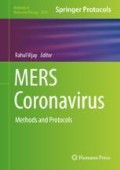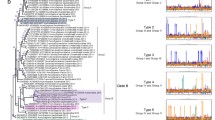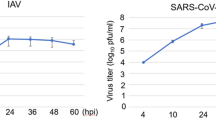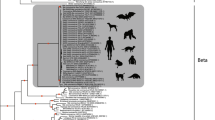Abstract
Forced viral adaptation is a powerful technique employed to study the ways viruses may overcome various selective pressures that reduce viral replication. Here, we describe methods for in vitro serial passaging of Middle East respiratory syndrome coronavirus (MERS-CoV) to select for mutations which increase replication on semi-permissive cell lines as described in Letko et al., Cell Rep 24, 1730–1737, 2018.
Similar content being viewed by others
Key words
- MERS-CoV
- Forced adaptation
- Experimental evolution
- Cell culture
- Semi-permissive cell line
- Host restriction
- Species barrier
1 Introduction
RNA viruses are ideal model organisms to study evolutionary genetics under selection. This is due to their large population sizes and short generation times, which are characterized by rapid accumulation of mutations relative to other organisms. Given the error-prone nature of viral RNA-dependent RNA polymerases, viral replication leads to the formation of a quasispecies [1,2,3]. Rather than one virus producing identical progeny during replication, a population of viruses is produced, each differing from one another by nucleotide substitutions or deletions as a result of errors incorporated by the RNA polymerase. While the majority of these mutations will have neutral or negative effects on viral fitness, a small subset of these mutations may prove beneficial and enhance the ability for certain variants to replicate despite selective pressures of interest such as the host immune response or an antiviral drug. Forced adaptation experiments have been used to determine viral mutations that facilitate escape from drugs [4,5,6], monoclonal antibodies [7, 8], host restriction factors [9,10,11], and species variation in host receptors [12,13,14] and to elucidate various viral mechanisms of infection and replication [15,16,17].
Within the laboratory setting, the strength of selective pressure can be adjusted by increasing or decreasing the levels of the restrictive factor, thus facilitating the rapid expansion of viral variants within the population of quasispecies that can overcome the applied selective pressure. The ideal environment is “semi-permissive”—allowing only low levels of wild-type virus replication. Below is the method employed to adapt MERS-CoV to a semi-permissive host receptor, Desmodus rotundus DPP4 . The techniques described below could be applicable to a wide range of experiments to better understand the adaptive capacity of various coronaviruses under specific selective pressures.
2 Materials
2.1 Cell Culture
-
1.
Semi-permissive cells: baby hamster kidney (BHK) cells which have been transduced to stably express Desmodus rotundus DPP4 (drDPP4 [12]. Briefly, the coding sequence for drDPP4 was cloned into a lentiviral expression cassette also encoding for mcherry-T2A-puromycin-N-acetyltransferase-P2A (System Biosciences) and used to generate lentiviral particles [9] (see Note 1). BHK cells were infected with lentiviral particles and then grown in DMEM containing puromycin at a final concentration of 1 ug/mL.
-
2.
Cell culture media: Dulbecco’s Modified Eagles Medium (DMEM), 10% fetal bovine serum, 1% l-glutamine, 1% penicillin and streptomycin, and 1 μg/mL puromycin.
-
3.
Passaging culture media: Dulbecco’s Modified Eagles Medium (DMEM), 2% fetal bovine serum, 1% l-glutamine, 1% penicillin and streptomycin, and 1 μg/mL puromycin.
-
4.
Light microscope to check cell cultures for cytopathic effects .
2.2 Passaging Experiment
-
1.
6-Well cell-culture cluster plates.
-
2.
MERS-CoV/EMC2012, passage 6. This virus stock was grown in-house and titered by standard endpoint titration on Vero cells [18].
2.3 Directed Sequencing of MERS-CoV Spike
-
1.
Viral RNA extraction mini kit.
-
2.
Superscript IV reverse transcriptase cDNA production kit.
-
3.
iProof High-fidelity PCR kit.
-
4.
Agarose gel purification kit.
-
5.
MERS-CoV Spike receptor-binding domain sequencing primers (see Table 1).
-
6.
Sequence analysis software capable of multiple sequence alignment and viewing chromatograms.
3 Methods
3.1 Prepare Cells for Viral Passaging
-
1.
Plan number of conditions. At least three replicates (well of semi-permissive cells) for each forced adaptation experiment should be performed in parallel. Critically, parental cells or a cell line stably expressing an irrelevant protein should be included to control for any nonspecific cell culture mutations.
-
2.
Grow semi-permissive BHK cells to confluency in appropriate format. One 75 cm2 flask should be sufficient to seed at least three 6-well cluster plates.
-
3.
Wash, trypsinize, count, and seed BHK cell lines (parental controls and semi-permissive) in cell culture media (10% FBS) at a density of 1.5 × 105 cells/mL in a 2 mL volume in each well of 6-well plates (see Note 2).
3.2 Infect Cells
-
1.
Twenty-four hours later, replace media on seeded cell lines with 2 mL of fresh passaging culture media (2% FBS).
-
2.
Infect cells with MERS-CoV/EMC2012 at a final MOI of 0.01 (Fig. 1).
Transduced cells are infected with wild-type stock. Approximately 72 hours later, supernatant from the infected cells is used to infect fresh cells as passage one. The process is repeated until the formation of cytopathic effects in culture. Supernatant from each passage is sequenced to detect the presence of adaptive mutations
3.3 Prepare Cells for Subsequent Passage and Passage Virus
-
1.
After 48 h postinfection, prepare new cell culture plates to passage virus. Follow initial seeding conditions and plate at a density of 1.5 × 105 cells/mL in a 2 mL volume in each well of 6-well plates.
-
2.
Twenty-four hours after seeding the new cells (72 h postinfection of previous culture), replace media on seeded cell lines with 2 mL of fresh passaging culture media (2% FBS).
-
3.
After 72 h postinfection for previous culture, take a 500 μL of supernatant sample from the infected culture and store for downstream viral sequencing. Store supernatants at −80 °C.
-
4.
Check previously infected cells for emergence of cytopathic effects (cell death, rounding-up, and detachment from cell culture plate in more than 50% of individual cultures) (see Note 3). If cytopathic effects are observed, this is strongly suggestive of viral adaptation to the semi-permissive cells. Proceed with step 3.4. Subsequent passages may be performed to select for further mutations that enhance viral replication in the semi-permissive cells (see Note 4).
-
5.
If no cytopathic effects are observed, then begin next viral passage: from the previously infected culture, transfer 250 μL of supernatant to the new cell cultures seeded the day before.
-
6.
Discard previously infected culture.
-
7.
Repeat steps 1–6 until cytopathic effects are observed, indicative of viral adaptation.
3.4 Extract Viral RNA and Sequence Spike
-
1.
Extract RNA from stored supernatants using the Qiagen viral RNA miniprep kit (Qiagen), following manufacturer’s instructions.
-
2.
Generate cDNA from extracted RNA using Superscript IV, following manufacturer’s instructions.
-
3.
Amplify select regions from viral cDNA using iProof high-fidelity PCR polymerase kit (Bio-Rad). Below are example PCR conditions for amplifying the MERS-CoV receptor-binding domain following the primer numbers listed in Subheading 2.2.5 of [12] (see Table 2).
31.5 μL
diH2O
10 μL
iProof buffer
5 μL
dNTP mix
1 μL
forward primer (10 μM)
1 μL
reverse primer (10 μM)
0.5 μL
iProof enzyme
1 μL
cDNA (from Subheading 3.4, step 2)
PCR Cycling conditions
Temperature
Time
98 °C
3 min
98 °C
10 s
1.1.40 cycles
50 °C
30 s
72 °C
30 s
72 °C
5 min
10 °C
Hold
-
4.
Gel purify PCR amplicons from 1% agarose using gel purification kit and following manufacturer’s instructions.
-
5.
Send each product for Sanger sequencing.
-
6.
Check Sanger sequencing chromatograms for overlapping peaks, indicative of mutations within a mixed viral population, as further described in [12]
4 Notes
-
1.
Importantly, this specific lentivector cassette is expressed under the Ef1α promoter, which allows for mid-level expression of the transgene as compared to other popular lentiviral transgene promoters such as CMV or CAGGS. This midlevel expression is ideal for semi-permissive selective pressure created by the transgene, in this case, drDPP4 .
-
2.
The plating density of cells may vary from this suggested value, depending on growth kinetics. In general, cells should be plated to achieve approximately 80–90% confluency on the day of infection.
-
3.
Cytopathic effects may be gradual to appear. To increase selective pressures on a viral population which is beginning to show signs of adaptation, one can apply a population bottleneck in the subsequent passage by reducing the amount of viral supernatant passaged to the next cell culture. In this case, we recommend reducing the passage volume by approximately tenfold.
-
4.
In our initial study [12], cytopathic effects were observed by the eighth passage; however, sequencing from earlier passages showed adaptive mutations emerging in the culture by the third passage. Depending on the strength of selection, the number of passages required to elicit adaptive mutations will vary.
References
Andino R, Domingo E (2015) Viral quasispecies. Virology 479-480:46–51
Domingo E, Sheldon J, Perales C (2012) Viral quasispecies evolution. Microbiol Mol Biol Rev 76(2):159–216
Lauring AS, Andino R (2010) Quasispecies theory and the behavior of RNA viruses. PLoS Pathog 6(7):e1001005
Bazmi HZ et al (2000) In vitro selection of mutations in the human immunodeficiency virus type 1 reverse transcriptase that decrease susceptibility to (−)-beta-D-dioxolane-guanosine and suppress resistance to 3′-azido-3′-deoxythymidine. Antimicrob Agents Chemother 44(7):1783–1788
Sato A et al (2006) In vitro selection of mutations in human immunodeficiency virus type 1 reverse transcriptase that confer resistance to capravirine, a novel nonnucleoside reverse transcriptase inhibitor. Antivir Res 70(2):66–74
McKimm-Breschkin JL et al (2012) In vitro passaging of a pandemic H1N1/09 virus selects for viruses with neuraminidase mutations conferring high-level resistance to oseltamivir and peramivir, but not to zanamivir. J Antimicrob Chemother 67(8):1874–1883
Shibata J et al (2007) Impact of V2 mutations on escape from a potent neutralizing anti-V3 monoclonal antibody during in vitro selection of a primary human immunodeficiency virus type 1 isolate. J Virol 81(8):3757–3768
Chai N et al (2016) Two escape mechanisms of influenza avirus to a broadly neutralizing stalk-binding antibody. PLoS Pathog 12(6):e1005702
Letko M et al (2015) Identification of the HIV-1 Vif and human APOBEC3G protein Interface. Cell Rep 13(9):1789–1799
Ooms M et al (2013) HIV-1 Vif adaptation to human APOBEC3H haplotypes. Cell Host Microbe 14(4):411–421
Ooms M, Letko M, Simon V (2017) The structural Interface between HIV-1 Vif and human APOBEC3H. J Virol 91(5):e02289-16
Letko M et al (2018) Adaptive evolution of MERS-CoV to species variation in DPP4. Cell Rep 24(7):1730–1737
Baric RS et al (1999) Persistent infection promotes cross-species transmissibility of mouse hepatitis virus. J Virol 73(1):638–649
McRoy WC, Baric RS (2008) Amino acid substitutions in the S2 subunit of mouse hepatitis virus variant V51 encode determinants of host range expansion. J Virol 82(3):1414–1424
Khasawneh AI et al (2013) Forced virus evolution reveals functional crosstalk between the disulfide bonded region and membrane proximal ectodomain region of HIV-1 gp41. Retrovirology 10:44
Das AT et al (2008) Optimization of the doxycycline-dependent simian immunodeficiency virus through in vitro evolution. Retrovirology 5:44
Westerhout EM et al (2005) HIV-1 can escape from RNA interference by evolving an alternative structure in its RNA genome. Nucleic Acids Res 33(2):796–804
van Doremalen N et al (2014) Host species restriction of Middle East respiratory syndrome coronavirus through its receptor, dipeptidyl peptidase 4. J Virol 88(16):9220–9232
Acknowledgment
Funding was provided by the Intramural research Program of the NIAID.
Author information
Authors and Affiliations
Corresponding author
Editor information
Editors and Affiliations
Rights and permissions
Copyright information
© 2020 Springer Science+Business Media, LLC, part of Springer Nature
About this protocol
Cite this protocol
Letko, M., Munster, V. (2020). Studying Evolutionary Adaptation of MERS-CoV. In: Vijay, R. (eds) MERS Coronavirus. Methods in Molecular Biology, vol 2099. Humana, New York, NY. https://doi.org/10.1007/978-1-0716-0211-9_1
Download citation
DOI: https://doi.org/10.1007/978-1-0716-0211-9_1
Published:
Publisher Name: Humana, New York, NY
Print ISBN: 978-1-0716-0210-2
Online ISBN: 978-1-0716-0211-9
eBook Packages: Springer Protocols





